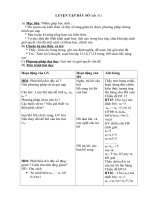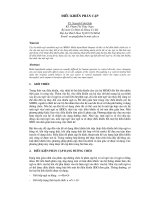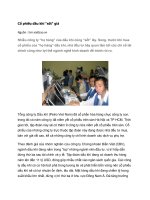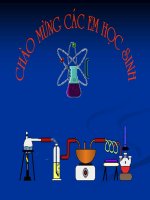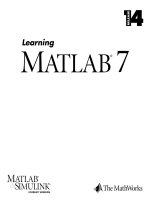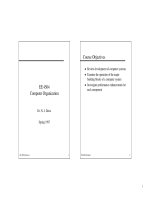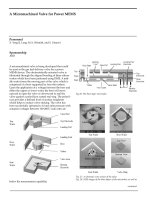Tài liệu INNOVATIONS FOR PAPER PRODUCTION pptx
Bạn đang xem bản rút gọn của tài liệu. Xem và tải ngay bản đầy đủ của tài liệu tại đây (2.22 MB, 32 trang )
APPLIED CHEMICALS INTERNATIONAL
SOUTH AFRICA
INNOVATIONS FOR PAPER PRODUCTION
INNOVATIONS FOR PAPER PRODUCTION
Polyvinylamines
Polyvinylamines
Anti Linting
Anti Linting
Biopolymers
Biopolymers
WINNING ENERGY OUT OF
WINNING ENERGY OUT OF
VIENNA SEWAGE SLUDGE
VIENNA SEWAGE SLUDGE
A Mega Project by EBS
A Mega Project by EBS
and the V
and the V
ienna City Government
ienna City Government
ACAT
ACAT SOUTH AFRICA
2
12
Issue 16
Applied Chemicals Anwendungstechnik
Technical Service is our Success
__ ___gqp
COVERSTORY
BondStar
®
Polyvinylamines
Biopolymers
Anti Linting
The FreshWave-IAQ Team - With the Aim to Conquer Europe
IFAT 2012: A Review on the Environmental Trade Fair -
a Highlight for our Application Technology Department
A Container Full of Technology
Sludge Dewatering in the Swiss Mountains
The Application of Dispersing Agents
“Daughter's Day“ at ACAT Vienna
The ACAT-Art Calendar 2013
Time is the Breath of Freedom
ACAT-Sponsoring
ACAT-Sponsoring
ACAT-Side Glances
Anniversaries, Newcomers, Special Occasions
Our Products
4 inside acat 2/2012
ACAT South Africa:
Our New Sales Office in Durban
EVENTS, NEWS
2
4
6
8
10
11
12
14
18
20
22
24
25
26
29
The Main Wastewater Treatment Plant EBS
Vienna realises the EOS project -
ACAT is part of it
MORE INFORMATIONS
We are expanding our sales network:
recently ACAT has established a new
branch in South Africa
BondStar
®
Polyvinylamines: ACAT en-
riches the BondStar
®
series with an
innovative further development
COMPANY NEWS
CONTENTS
TECHNICS
Imprint inside acat issue 16, December 2012
Owner, publisher and © ACAT International CH-4015 Basle, Neubadstrasse 7
T: + 43 1 979 34 73 • F: + 43 1 979 34 73-14555 • e-mail: • Website: www.acat.com •
Editor: Dr. Gildis Grabner • Layout: Fritz Prasek, Dieter Spet • Cover: Petra Spiola • Photos unless indicated otherwise: : ACAT •
printing: papercomm druckmakler Wieselburg, 3250 Wieselburg
__ ___gqp
inside acat 2/2012 1
Dear readers,
this is already the 16th issue of our company maga-
zine and again it focuses on paper and board pro-
duction, which is one of the main pillars of our busi-
ness. It seems that our modest publication is very
popular among an increasing number of readers.
We were surprised and pleased about that and we
are really motivated to continue. As we are trained
technicians some articles do not read very professio-
nally. None of us is trained as a journalist, but two
times a year we are enthusiastically on board and
dabble in writing to inform our readers about news
and activities of our company.
The time of reading should not be a senseless time
and with this in mind each issue of “inside acat“ is
produced. Of course, we have the advantage that
there is no great need to increase reader numbers
or circulation or to have better headlines than our
competitors and so free from those constraints we
can report on our own experiences, insights and
results, which we obtain in the course of our busi-
ness activities in the areas of environmental techno-
logy, industrial chemicals and paper industry. Inde-
pendence and impartiality allows honest reporting,
and maybe this is a pleasant contrast to most of
today's media.
On the following pages you can read lots of news
and interesting information about the paper and
board industry, where technological development is
taking giant steps forward. Rapidly changing condi-
tions require ongoing new developments for this
very ecofriendly industry. Today paper and board
are virtually 100% recyclable, and the increasing
series of cycles require new production technolo-
gies, to obtain the usual strength and characteris-
tics of the final product. You will find more on this
topic on the following pages.
It is surprising that public opinion still ignores the
enormous efforts of the paper industry in terms of
environmental friendliness and sustainability. The
common opinion is, - you can read it in many e-mail
attachments - that for paper-and board production
trees have to die. “Printing an e-mail is killing
forests” is latently suggested there.
To a large extent people of industrial countries dis-
pose of their waste paper in waste separation sys-
tems, but they are often not aware of the fact that
today this waste is the main raw material used in
paper production and the main virgin fibers origi-
nate from sustainably managed forests. The extre-
me glorification of the e-paper, which is based pre-
dominantly on commercial grounds, is beginning to
have an impact on paper consumption. That has
nothing to do with environmental care, considering
that compared to the recycling of electronic compo-
nents the recycling of paper is very easy.
Maybe paper and board need a broader setting
concerning environmental friendliness. This has
already been successful in the competition with
paper bags against plastic bags.
Everyone should know that he acts environmentally
friendly, when he buys prints for reading books or
newspapers or when he presses the button for a
printout, and writing a letter or making graphs are
not detrimental to the environment.
Paper is an important part of our culture and it is
one of the most ecofriendly products of our civilisa-
tion. A great deal of educational work is still requi-
red in our society to lead public opinion in the right
direction. I am sure, that the competent authorities
will work to ensure that this will happen soon.
With this in mind, I wish our loyal readers joyful fes-
tive days and a happy, successful New Year - with
increasing paper consumption.
Manfred Zabl
CEO Applied Chemicals International AG
Photo: Spiola
EDITORIAL
Manfred Zabl
_ __g qp
2 inside acat 2/2012
NEWS, EVENTS
ACAT SOUTH AFRICA
Our New Sales Office in Durban
In June 2012 ACAT expanded by opening a sales office in Durban, South Africa.
The ACAT ZA organisation will focus primarily on the South African Pulp and Paper
Industry, with a view to expand into the environmental sector as well. Durban is ideally
placed to provide a centre for the ACAT activities in South Africa.
June 2012 Overview
As the worldwide recession pales, the local pulp and
paper industry has settled out with some grades of
paper showing small growth in demand. Selected
grades of pulp, packaging and tissue are still produ-
ced sustainably in South Africa, however, with rising
imports, increasing costs and global over capacity in
products like newsprint; profitability and therefore
the sustainability of producing certain grades in
SOUTH AFRICAN PULP AND PAPER INDUSTRY
Summary findings from 2011 production, import and export statistics
Photo: wikipedia/PhilippN
_ __g qp
inside acat 2/2012 3
South Africa may be a challenge going forward.
Printing and writing grades are definitely under
some pressure.
Please note that all graphs are indexed against 2006,
which has the value of 100.The left axis is a numeri-
cal value given to a product relative to its perfor-
mance in the base year of 2006.
South African consumption profile
Overall, consumption per capita has risen, driven by
the increased consumption of packaging and tissue.
Printing and writing grades are, however, showing
the first indications of a per capita decline. The 0,86
kg/per person change is a statistically significant
movement given that, generally speaking, we are no
longer seeing the effects of massive stock changes
related to the recession’s impacts on packaging and
paper. However, as South Africa’s Living Standards
Measure profile develops, so tissue and packaging
demand should grow.
Author: Arthur Austin
_ __g qp
4 inside acat 2/2012
After the successful introduction of our dry strength
agents based on GPAM (glyoxylated polyacrylami-
des) we add now two new products based on poly-
vinylamines (PVAm) to our portfolio of dry strength
agents and additives to increase the efficiency. The
products are:
BondStar
®
206L und BondStar
®
284L
Mainly on older types of paper machines like four-
drinier machines, top wire formers or paper machi-
BONDSTAR
®
POLYVINYLAMINE
ACAT enriches the BondStar
®
series with a further
innovative development of known technologies
AUTHOR: NURI KERMAN
COVERSTORY
nes equipped with a dandy roll they can increase
the dry content and they can deliver an increase of
speed of up to ten percent. This effect is mainly due
to the formation of a fine flock structure which has
a positive impact on the vacuum dewatering and on
the dewatering behavior at the press section. In
addition to the side effect of increasing strengths
the efficiency of the paper machine can be impro-
ved by the reduction of web breaks.
With the application of the new products in fine
papers it is possible to produce papers with higher
fillers content without significant loss of strength.
With the following case study we want to discuss
this advantages in more detail:
Photo: Spiola
_ __g qp
inside acat 2/2012 5
Case study: packaging paper machine:
Type of paper:
• Testliner 1-3
Paper machine:
• Top: top wire former, back: fourdrinier wire
• 170.000 t/a production
• speed 600 - 820 m/min
• 150 – 240 g/m²
• retention agent RetStar
®
205P, 320 g/t
Dosing point and quantity:
• Test 1: Dosing between mixing and machine chest
(high density pulp)
• Test 2: Dosing before the headbox pump
(low consistency pulp)
• dosing quantity: 9,5 kg/t BondStar
®
206L
Results test 1:
• increase of paper machine speed 3%
• increase of SCT: plus 15%, burst pressure:
plus 17%
• reduction of retention agent 30%
• reduction of vapour 2,5%
• reduction of breaks 37 %
Results test 2:
• increase of paper machine speed 7%
• increase of SCT : plus 8%, burst pressure:
plus 12%
• reduction of retention agent 50%
• reduction of vapour 4%
• reduction of breaks 26%
Conclusion:
If the focus is on the improvement of strength, it is
better to dose the agent at the high density area.
If the focus is on an increase of speed, it is better to
dose the agent near the head box.
To prove this in practice the staff members of the
ACAT application technology department would be
happy to introduce the advantages of this specific
development of the already known polyvinyl tech-
nology to interested customers in laboratory and
machine tests.
for chemical-paper-food-water-wastewater-industry
A-2514 Traiskirchen, Lerchengasse 1
T 02252-562 94, F 02252-570 28
M 0664-522 77 37
www.dosiertechnik.at
(1) BondStar
®
206L
(2) BondStar
®
206L
RetStar
®
_ __g qp
• reduces fines and acts as a fixing agent
• enhanced fines and filler retention without
loss of strength
• higher retention of the additive
• reduced water retention compared to
starch, and therefore reduced steam
consumption
• increase of productivity because of higher
machine speed
• increased strength in z- direction
• reduces dusting and picking
• possibility to adapt creping properties at
tissues either to maximise production or to
improve softness
• handling compared to cationic starch is
much easier
• durability 6 to 12 month
• solids content 20 and 40%
The typical dosing points for these products are in
the high-density area as shown in the figure at
page 7.
6 inside acat 2/2012
BIOPOLYMERS
Enhancement of strength, Anti Linting, Fixing and
AS Emulsification on Biological Base in Top Quality
AUTHOR: NURI KERMAN
For 12 months, ACAT and the Finnish company Che-
migate OY have cooperated in the field of highly
cationic bio-polymers based on barley starch. These
are known in large parts of Europe and South Afri-
ca under their trade names BondStar
®
and FixStar
®
.
Due to their versatility, biopolymers have received
greater attention in recent years. They can be used
• as a dry strength agent
• as a retention- and dewatering agent
• as a fixing agent
• for the ASA emulsification
• in water water treatment
• against dusting and linting
• to improve printing propertiesn
Modern large paper mills and especially smaller
paper mills benefit from their use. Because of their
various features producers of tissue paper can use
biopolymers as a dry strength agent, as a retention-
and dewatering agent, as a fixing agent as well as
against dusting and linting. These examples show
that with one and the same product different pro-
perties are affected simultaneously. A number of
treatment plants and the storage of some chemicals
are no longer necessary.
With a pump the biopolymers are dosed directly
from the container or from the storage tank. In
contrast to the classical cationic starch no expensive
starch cooker with periphery is needed.
Biopolymers offer the following advantages:
• flexible, soft film, no fibre breakage
Natural raw material:
the biopolymers BondStar
®
and
FixStar
®
are based on barley starch
Photo: Andreas Hermsdorf/pixelio.de
_ __g qp
Case study:
Aim:
• to enhance strength of paper and to
reduce dusting
Actual status:
• Tissue production 23000 t/a
• 16 - 50 g/m²
• 100% recycled fibres
• vPM: 1220 m/min
inside acat 2/2012 7
ACAT Presents Paper-Tech-Portfolio at Pap-For 2012
PAP-FOR is the largest and
oldest exhibition for all
sectors of the paper indus-
try - from pulp to paper
processing and paper fin-
ishing. The exhibition takes
place every two years and
it is a meeting place for
manufacturers and suppli-
ers of papermaking equip-
ment, chemicals, mea-
surement equipment, and
products of related indus-
tries with the manufactur-
ers of pulp, paper and
board. It has been record-
ed as being the most
remarkable event in Rus-
sia's pulp and paper indus-
try. The aim of the exhibi-
tion is to present the latest
developments and tech-
nologies from regional and
international markets.
At the booth of our sales
partner, BumTechno, ACAT
was one of the exhibitors
at this major event in St.
Petersburg. We introduced
our extensive portfolio and
we could strengthen our
position in Eastern Europe
in numerous and detailed
discussions and we forged
ties with a number of new
clients.
PAP-FOR The International Exhibition for Wood Processing,
Pulp and Paper Industries - ACAT was among the exhibitors
Results:
• 4 kg/t BondStar
®
300L 15 vor before pump
machine chest
• refining energy reduced from 40kW to
30kW for achieving the same strength
• reduced dusting at processing
• higher retention up to 25%
• steam consumption at the Yankee-dryer
6% less.
Examples for the dosing of BondStar
®
und FixStar
®
at the high-density area
_ __g qp
8 inside acat 2/2012
ANTI LINTING
Offset linting of Newsprint and Uncoated mechanical papers has been an ongoing quality
issue for many years. With the increased use of recycled deinked fibre and increased
printing speeds, the issue can have a major effect on press runnability and print quality.
AUTHOR: HOWARD JOHNSTON
Linting is the removal of materi-
al from the surface of Newsprint
and Uncoated Magazine Papers
during offset printing and can
result in reduced image quality
and press productivity.
Piling is the term used for a
build-up of ink and ink compo-
nents and paper linters onto the
printing blanket, and is of major
concern for web printers becau-
se of the waste generated and
the time taken to clean the blan-
ket. As the material builds up on
the blanket, the thickness increa-
ses in local areas and print quali-
ty will deteriorate. Generally this
build-up will be in the non –
image areas of the blanket and
worse at the trailing edge of the
solid printed areas.
Linting can be caused by a num-
ber of factors:
1. Excessive tack of the ink or
blanket. This is the force exerted
by the filaments of the ink film
as it splits. Possible solutions to
this include adjusting the ink for-
mulation and adjusting the
fountain solution by the inclusi-
on of release agents.
2. A major source of linting is
poor surface strength of the
sheet allowing paper fibres and
filler to be pulled from the surfa-
ce of the sheet and build up on
the blanket. This can be exacer-
bated by too high penetration of
ink or water into the paper sur-
face.
A paper with a high linting ten-
dancy will almost certainly cause
Photos: The faster times (1), hclp.net (1)
_ __g qp
inside acat 2/2012 9
a much higher frequency of pro-
duction stops for blanket clea-
ning with a consequent increase
in waste generated and time
lost.
Typical lint reduction mecha-
nisms in the paper mill will inclu-
de:
• Adjust refining
• Remove dissolved solids
• Reduce recirculation of paper
fines
• Retain ray cells more evenly
throughout the sheet or
improve cleaners to remove
more ray cells
• Adjust drying profile
ACAT has developed a new pro-
duct SizeStar
®
300L to reduce the
frequency of linting problems by
addressing the fundamental issu-
es of surface strength characte-
ristics, ink and water holdout.
SizeStar
®
300L is a internal sizing
polymeric additive which con-
tains a semisynthetic polymer in
combination with a range of
hydrophobic agents to improve
the printing characteristics of
Newsprint and Uncoated Maga-
zine grades. SizeStar
®
300L will
give better control of sheet hy-
drophobicity with a subsequent
improvement in offset printing
performance and decreased lin-
ting and dusting.
Use of SizeStar
®
300L will impro-
ve:
• Sheet smoothness
• Linting propensity
• Ink and water holdout
• Printability
• Dimensional stability
• Pressroom runnability
_ __g qp
Odour neutralisation with essential oils is of great inte-
rest for the industry using Ecosorb and for the com-
mercial application using FreshWaveIAQ. Across the
structure of our company a whole host of people is
responsible for the first successes.
10 inside acat 2/2012
THE FRESHWAVE-IAQ TEAM
Our Aim: The Conquest of Europe
The planned marketing strate-
gy is that FreshWaveIAQ is
mainly marketed by local distri-
butors.
Aldo Randisi is responsible for
the development and the sup-
port of the distribution net-
work, he organises sales trai-
ning and represents ACAT at
European exhibitions. We in-
tend to support these activities
with an additional assistant
soon. Customers also have the
option to order the product
under their own brand (private
label).
This demands internal
management of the order pro-
cess, which is undertaken by
Petra Stierli. Production and
bottling take place in Scheibbs.
Theo Weinbrenner is responsi-
ble for the production and the
raw material acquisition, Iris
Spieler fills the bottles and
labels them and Mario Lang-
wieser packages the bottles
and makes them ready for
transport. Storekeeping and
administrative issues are in the
hands of Sabine Spieler and
Helga Rolek. Finally the entire
responsibility for the product
quality lies on the shoulders of
Theo Weinbrenner.
In addition to this ”hands-on“
activities a lot of background
work has to be done , which is
the foundation of the high
quality of the product.
Edith Haas is responsible for
supply and replenishment. As
our products are used in health
and in hygienic fields, our
“International Business Sup-
port Team“ , headed by Ale-
xander Frank, assisted by Karin
Pruckmair, has to ensure that
the safety documentation on
marking and labelling of the
products is in accordance with
the law. They are also responsi-
ble for the necessary approval
procedures.
I would like to take this oppor-
tunity to thank all those invol-
ved for their unflagging efforts
that have already borne fruit.
Aldo Randisi
Petra Stierli
Theo Weinbrenner
Sabine Spieler
Helga Rolek
Karin Pruckmair
Mario Langwieser
Iris Spieler
Alex Frank
AUTHOR: PER BJÖÖRN
_ __g qp
inside acat 2/2012 11
IFAT 2012: A Review of the Environmental
Trade Fair - a Highlight for Application Technology
More than six months have passed since the IFAT 2012 took place in Munich, but we
still notice the after-effects.
If combined with the solar StorageDryer of Thermo
System (Stuttgart) it provides an essential part of
the mechanical pre-dewatering before the sludge
is carried to the drying hall. This version is used by
our partners worldwide.
This resonance and the already existing references
for our small screw press inspires us to expect great
things.
With our screw presses we also reached the Ger-
man market. The combined efforts with our distri-
bution partner “Werkstoff+Funktion (Ober-Mör-
len)” at the IFAT was a success, generating many
requests for demonstrations, also including impor-
tant reference projects.
In addition to the presentation of our latest deve-
lopments it was a pleasure for us to chat with old
friends and new clients and to exchange experi-
ences with a glass of wheat beer and some snacks.
We thank all visitors for their interest and their visit
to our stand and all our ACAT colleagues for their
exceptional personal commitment during IFAT.
Now there is intense activity in our laboratories
and at our testing plant following the motto: “sta-
gnation is regression”.
IFAT 2014 - we will definitely be there again!
This year some project contracts can be directly
related to our presence at this exhibition and some
order options are still in process. From the per-
spective of the plant engineering of ACAT, an
essential part of this success can be ascribed to the
international presentation of the ACAT screw press
505 S. In many discussions we were able to convin-
ce interested customers of our real interest concer-
ning the development in process engineering, of
the high manufacturing standard, the easy main-
tenance and the high quality of materials used for
our products.
For the first time we also had a stand outdoors
with the new ACAT screw press AS 250. Sometimes
the rush of visitors was so high that despite our
efforts, long queues formed, up to dimensions you
normally only see at attractions like the Europa-
Park in Germany.
The compact concept of the press is offered in
various standard versions and it is very economical.
It meets the requirements of small sewage treat-
ment plants and so the interest of the customers
was high.
AUTHOR: EWALD KERN
Heavy influx of visitors
at the ACAT outdoor stand
In the center of attention:
ACAT screw press 505 S
_ __g qp
12 inside acat 2/2012
Currently the sludge obtained
from the sewage clarification in
the Main Wastewater Treatment
Plant in Vienna EBS is thickened,
dewatered and finally burned.
But the sludge contains high
amounts of organic material. For
the foreseeable future it is plan-
ned to convert this material with
a sewage sludge digestion in six
digestion towers into methane
and the obtained methane into
electric power. So the EBS will be
able to produce the entire ener-
gy requirement for the waste
water treatment. Further bene-
fits of this measure are to be
found in the ecological sphere,
where an amount of savings of
approximately 40.000 tons of
CO
2
equivalent is expected.
The Vienna City Council has deci-
ded to realise the project “EOS -
Energy Optimisation in Sludge
Treatment“ by 2020.
The engineering office Dr. Len-
gyel ZT GmbH was entrusted
with the planning of a pilot
plant for the sludge digestion,
which is necessary to generate
new knowledge for assessing the
technical details and for the
optimisation of the operation.
One part of the pilot plant is a
sludge dewatering for the drai-
nage of the sludge with the
main focus on the digestion fil-
trate water (turbid water). In a
separate turbid water treatment
system, nitrogen is degraded in
biological processes. With special
procedures like deammonificati-
on it is possible to realise signifi-
cant nitrogen decomposition
with low energy consumption in
a partly ventilated reactor.
The complete system consists of
one buffer container and two
turbid water containers. The tur-
bid water is discharged directly
from the sewage dewatering
plant into these containers. The
treatment of the turbid water is
operated on the proven princi-
ple of SBR in an aeration plant.
Alternately the previously aera-
ted activated sludge is allowed
to settle and the supernatant is
removed.
ACAT is pleased to be entrusted
with the planning, construction
and startup of the compact slud-
ge dewatering unit which is
equipped with the ACAT screw
press Type AS 250.
The screw press AS 250 is best
suitable for this application be-
cause it is designed for a
throughput of 0,3 - 1,0 m
3
/h or
10-20 kg DS/h depending on the
sludge quality.
The complete dewatering unit
plus its associated periphery is
installed within the smallest
space in a container that is also
suitable for winter operation.
Plant Description
With a thin sludge-eccentric
screw press the digested sludge
is pumped from the sludge piling
containers into a mixing reactor
where the sludge conditioning
with an agitator takes place. Be-
fore entering the container a
polymer solution is added at a
special injection point.
The polymer solution is prepared
in a polymer processing plant,
where the concentrated liquid
flocculent is diluted with water
to the determined concentrati-
on. The required mixing energy
is gained from a high perfor-
mance mixer. The totally condi-
A CONTAINER FULL OF TECHNOLOGY
By 2020 the Main Wastewater Treatment Plant in Vienna EBS wants to realise a project
called “EOS – Energy Optimisation in Sludge Treatment“. ACAT is part of it.
AUTHOR: RONALD POELGEEST
_ __g qp
ACAT is proud to make a small contribution to this pre-project, and we wish the
operators lots of success for the realisation of this project!
tioned sludge is pum-
ped with a slight over-
pressure into the
screw press for dewa-
tering. The filtrate
water runs into a
separate filtrate sto-
rage tank and is final-
ly pumped into the
turbid water contai-
ner. The dewatered
sludge is conveyed
with a heavy-duty pis-
ton pump through a
pipe into the sludge
container.
Further components
of the sludge dewate-
ring unit are: a com-
pressor for the gene-
ration of compressed
air, measuring instru-
ments for the measu-
rement of the water
flow rate, sludge and
a polymer solution, a
pressure controller
and some other mea-
suring and control
devices to ensure a
fully automatic opera-
tion.
The entire dewatering
process is regulated
with a control unit
operating with SPS.
For the operation of
the control unit a
touch panel is used.
The system is desig-
ned for unattended
24- hour operation.
Because of the extre-
mely low speed of the
screw press (0,2 -
1,5 min
-1
) the wear is
reduced to a mini-
mum.
inside acat 2/2012 13
ACAT Screw Press Type AS 250 including pump for dewatered sludge
Photo: Christine Nestler-Kenzian
_ __g qp
14 inside acat 2/2012
SLUDGE DEWATERING
in the Swiss Mountains
With the order for sludge dewatering at the municipal sewage treatment plant in
Engelberg, ACAT has created a reference in the center of Swiss tourism.
Engelberg is a municipality in the canton of Obwal-
den in Central Switzerland. The name of the place
comes from the Benedictine monastery Engelbert
founded in 1120. The village is situated on a flat
high valley at an altitude of roughly 1050 m above
the sea between the 3238 m high Titlis in the south
and a mountain range in the north with the moun-
tains Engelberger Rotstock, Ruchstock, Rigidalstock
and the Walenstöcken rising 2800 m high. The
charming village is dominated by the 2600 m high
AUTHOR: RONALD POELGEEST
Photo: Berggeist007/pixelio.de
_ __g qp
inside acat 2/2012 15
mountain Hahnen. Today Engelberg has 4400 inha-
bitants, who live in a place where others spend their
holidays.
In the middle of the 19th century Engelberg was dis-
covered for tourism, which became the most impor-
tant economic factor in the 20th century. With the
opening of the Stansstad-Engelberg electric railway
winter tourism started, which is now also a key eco-
nomic factor for Engelberg.
With more than 11.000 guest beds and approxima-
tely 800.000 overnight stays Engelberg is one of the
strongest tourist municipalities of Switzerland.
Anyone who has spent their holidays in this region
can confirm this. Due to the mixed slopes for every
level of ability and the reliable snow coverage it is a
very popular ski area. But also in summer one can
find lots of opportunities for sporting activities like
hiking and climbing - or just for relaxing. Also for
adrenaline junkies it is a real paradise.
Such enthusiasm makes it difficult to devote my
attention to the original topic, but in tourist regions
a large amount of waste water is produced and that
has to be treated.
In 1967 the first simple waste water treatment plant
WWTP started operation and in 1978 the larger
plan, which still exists, was put into operation.
For 45 years Engelberg has a waste water treatment plant - always according to
state-of-the-art technology - that helps to keep the beautiful surrounding area clean
Photo: KA Engelberg
_ __g qp
16 inside acat 2/2012
Because of the high demands at that altitude and
the steadily increasing tourism since commissioning,
a value maintenance concept was developed that
meets the existing financial resources of the munici-
pality.
Since 2008 the proposed measures of planners and
management have been implemented at a cost of
CHF 8.300.000.
Own Power Generation and Biogas Plant
In the course of the reconstruction the WWTP was
extended to a capacity of 15.000 inhabitants. Fur-
thermore in 2010 a small-scale hydro production
SHPP was built at the discharge of the WWTP for
the generation of electricity from the treated waste
water. The power plant has an output of 40kW. The
additional costs amounted to CHF 850.000.
In 2011 the obsolete combined heat and power sys-
tems CHP was replaced by a new, more efficient sys-
tem that converts the biogas produced during the
sewage treatment process into electrical energy.
It is planned, that in October 2012 a small photo-
voltaic system will be installed on the roof of the
plant. After the energetic refurbishing of the façade
of the building the CHP (with 50 kW electrical
power) will cover the entire heat requirement of
the WWTP, so soon not a single drop of heating oil
is required for the operation of the plant.
All these energy generation initiatives enable the
The screw press achieved dewatering results
that the WWTP plant operator never did expect
_ __g qp
Recently the municipality of Engelberg obtained
the label "Energy City", which proves that the
municipality has made special efforts in environ-
mental and energy fields.
We know that technicians arriving to support a
screw press are not the target group of the local
Tourist Board, but we are already looking forward
to visiting WWTP Engelberg occasionally to admire
the beauties of this region with its mountains,
lakes, forests and willows, whilst ensuring the effi-
cient operation of the WWTP.
Many thanks to all participants for their excellent
collaboration! We really would be happy to come
again.
inside acat 2/2012 17
WWTP to generate an electrical power of 450.000
corresponding to the consumption of approximate-
ly 100 households. So WWTP can produce about
60 % more power than needed. Work started in
2008 and will be finished in 2013.
The measures for the maintenance of value also
included the replacement of the existing sludge
dewatering. In the course of a public tender ACAT
was awarded the contract to supply and install the
new sludge dewatering unit. As a preliminary,
extensive dehydration tests were carried out and
the results achieved by the ACAT screw press excee-
ded all expectations. Also the very low energy
demand of the screw press fits to the environmen-
tally friendly energy supply concept of the WWTP.
_ __g qp
Particle sizes and surfaces
Dispersing
Agents
Part i cl e size
(μm)
Sur f ace
(m² / g)
Inorganic Pigments and Fil lers 0,3 – 5,0 5 – 20
- Calci um Carbonate 3 – 8
- Titanium Dioxide 0,3 – 1,0 8 – 15
- St andard Iron Oxide Red 0,1 – 1,0
Organic Pigments 0,05 – 1,0 50 – 100
- Pht halo Cyanine Blue 0,06 – 0,1 30 – 120
Car bon Bl acks 0,05 – 0,5 30 – 1600
- furnace black 0,05 – 0,1 15 – 50
- gas black 0,005 – 0,03 100 - 1000
Transparent inorganic pigments
- transparent Iron Oxide Red 0,001 – 0,01 500 - 5000
18 inside acat 2/2012
is the wetting of the pigment surface, thereby the
adsorbed air is displaced from the particle surface.
Then the pigment agglomerates are destroyed by
mechanical shear forces. Finally, the dispersion is
stabilised to prevent a further agglomeration of
the particles (see table 2). For mechanical dispersi-
on dissolvers or mills are used.
The following parameters are the decisive factors
for the dispersing properties of the pigments
• density
• chemical composition
THE APPLICATION
OF DISPERSING AGENTS
First of all I want to deal with pigments and the
dispersing process, primarily with the dispersion
and stabilisation of the pigments in aqueous soluti-
ons. The key criteria are particle size and the speci-
fic surface of the different pigments and fillers.
Some of the most important products are presen-
ted in table 1.
The dispersing process consists of three stages. First
AUTHOR: ALEXANDER FRANK
ACAT distributes a number of dispersing agents from Münzing Chemie. I want to introdu-
ce some fields of application of our various products.
Table 1
_ __g qp
inside acat 2/2012 19
• production process
• crystal structure
• size of particles
• surface treatment
• surface conditions
The dispersing agents have to meet the following
requirements:
• wetting > displacement of air and humidity
• support of the grinding process > short dispersing
time, optimal degree of grinding
• stabilisation of the dispersion > colour intensity,
shine
• reduction of the viscosity of the grind
> high charge of the pigments, viscosity
• good compatibility with resins > no flocculation
or coagulation, wide range of possible applica-
tions
• no influence on coatings > water repellence,
coating properties.
The stabilisation of the dispersion is based on seve-
ral effects depending on the dispersion agent used.
It may be either an electrostatic stabilisation,
where the charge of the dispersing agent plays an
essential part, or a steric stabilisation, where the
chemical construction and the molecular weight of
the dispersing agent are the key factors. If the
wrong agent is used problems may occur:
• Bad dispersion
o agglomerates or aggregates will remain in
the colour
o rub – out effects occur
o a low colour intensity
• Flocculation of the already settled ground
pigment
o loss of shine, settling, bad flow behaviour
• Incompatibility of the binding agent
o reduced covering capacity, bad flow
behaviour
Our supplier Münzing Chemie, offers a large num-
ber of laboratory tests for the selection of the most
suitable agent and we can offer this service also to
our customers. Our sales team will be happy to
advise you on the optimal use of our products.
Dispersing process
Dispersing
Agents
aggregates
occulated air
agglomerates in
powderous form
wetted agglomerate
dispersed Pigment
Table 2
_ __g qp
Report ACAT-Applied Chemicals -
Anwendungstechnik GmbH
What kind of company is the Applied Chemicals
Anwendungstechnik GmbH??
ACAT is a Swiss company that has a worldwide presence
through its own branches in Italy, Hungary, Austria,
England, Singapore and South Africa.
The activities are:
1) chemicals for paper industry - worldwide
2) chemicals for sewage treatment
3) environmental, mechanical and plant
engineering in Europe
4) chemicals for construction, paints and coatings
Questions for the staff:
1. What is your job at ACAT?
2. What was your job training how long was the
duration of your education?
3. Why did you choose this profession?
4. What do you like most about your job?
5. How many hours a day do you work?
6. Do you like your job here?
(Note: all of the respondents answered this question
with “very good”)
Interview partner Alex Frank:
1.) I am head of the Department „Industrial Chemicals“
and I am responsible for international business, data
sheets, contracts, buying and selling prices and so on.
2.) Six years HTL for Chemistry
3.) Because of personal freedom, I can organise my work
on my own
4.) Because it is diversified and demanding
Interview partner Gerhard Zima:
1.) I am a sales representative for paint and coating.
2.) HTL (TGM) for technical and analytical chemistry; this
is my 6th job; with every job you can learn something
new.
3.) You can meet many different people, offer technical
solutions, sell products and if you are successful it
feels good,
4.) Flexible working hours and success
20 inside acat 2/2012
„DAUGHTER'S DAY“ AT ACAT VIENNA
AUTHORS: MAREN KIRCHNER & LAURA HORAK
ALEXANDER FRANK (INTRODUCTION)
INFORMATIONS
On 26 April 2012 „ Daughter's Day“ was held for
the tenth time this year in collaboration with the
Vienna Chamber of Commerce and the Vienna
School Council. On this day girls between the ages
of 11 and 16 get to know companies from various
industries, with a focus on trade, engineering and
science. Daughter's Day is designed to make young
women aware of future-oriented training opportu-
nities of non-traditional vocations, which are often
better paid. In Vienna about 50% of the girls are
still choosing one of the classic female professions:
hairdresser, trained retail saleswoman and office
clerk.
ACAT Vienna was visited by Maren Kirchner und
Laura Horak (11 years). First the two girls had a gui-
ded tour through our office. Then they conducted
interviews with some employees to obtain an
insight into the different professions within the
company.
It’s great that the two girls drew up a comprehensi-
ve report at home. For reasons of space we only can
give an extract of it. The complete report and the
interview questions are the work of Maren Kirchner
und Laura Horak only. Now it is Maren and Lauras
turn:
This year more than 179 companies participated in the „Daughter's Day“ in Vienna, where
girls between the ages of 11 and 16 get the opportunity to gain an insight into future-
oriented jobs – this year also into the ACAT office.
_ __g qp
inside acat 2/2012 21
Interview partner Susanna Weinrother:
1.) I prepare invoices and I plan and coordinate the
work assignment of the installers and technicians
for our various projects
2.) Matura (HBLA)
3.) I have nice colleagues and my work is really
varied
5.) I work 30 hours a week
Interview partner Karin Pruckmair:
1.) I am responsible for security issues
2.) Successful completion of AHS, university and a
College for plastics technology (it took three and
a half years)
3.) I like many things here, one of it is that I can
spend much time with my children although I am
working
4.) I can live out my tendency towards
perfectionism
5.) I work 24 hours a week
Interview partner Michael Fuchs:
1.) I work at the Paper department and I am
responsible for orders and transport.
2.) AHS (8 years) & Matura
3.) By pure chance
4.) Because my job is very diverse.
Interview partner Andreas Nikel:
1.) I am responsible for all matters concerning IT,
internet connections and communication (mobile
phone)
2.) AHS Matura, self- study and practice
3.) It simply happened
4.) Because it is a job with much variety
Interview partner Christine Nestler-Kenzian:
1.) I support the CEO; make travel planning for
business trips and contracts
2.) Matura at a Tourism School (at the age of 19)
Following this I worked in England for one year
and later I took a job at a hotel
3.) Because it is close to my home and because it is
very interesting
4.) Because my job is very diverse.
Interview partner Harald Reis:
1.) I am responsible for invoices and accounting
2.) Matura, then I spent four years for studies at the
Vienna University of Economics and Business
Administration
3.) Because of my interest and feeling for numbers
4.) Because it is a job with much variety
We enjoyed our day at ACAT very much. It was
funny and interesting, and we have talked to many
nice people there. We have learned to approach
others and communicate with them confidently. We
had a guided tour through the laboratory and the
entire company building. It was a great day with
much information.
On „ Daughter's Day“ Maren Kirchner and
Laura Horak (11) came to ACAT to gain
knowledge about our job-life
_ __g qp
ter. Wherever you may look,
today`s world is loud, bright
and hectic – not only in profes-
sional life, but also in private
life.
Our aim should be:
FREE TIME instead of LEISURE
TIME!
Let us be honest: How often
do we postpone things we
really want to do to a later
date? Maybe because the
timing is not perfect, because
there is a need to consider fel-
low men, because…
Every single moment is life! Let
us have the courage to stop.
No one can halve or quarter
himself. Therefore it is time to:
In our daily life we are rushing
from one appointment to an-
other, from one decision to the
next one - we are always on
22 inside acat 2/2012
ART-CALENDAR
TIME IS THE BREATH OF FREEDOM
The ACAT-art calender 2013 with pictures taken by the Vorarlberg photographic artist
Reinold Amann deals with time, a valuable commodity we should use effectively.
AUTHOR:
GERTRUDE MITTERBÖCK
I wish you more time, because it is the breath of freedom. Hans Kruppa
the go. Since the last century
the speed of our life has in-
creased continuously, develop-
ments are going faster and fas-
_ __g qp
inside acat 2/2012 23
STOP the world, RELAX!
Slow down and concentrate on
yourself.
Do nothing at all.
Turn your gaze inward for a
while; hear, say and see no-
thing.
Find peace, learn to relax,
rediscover the pleasure of
inside, the silence was not easy
to bear. It was hard for me to
slow down, but it was worth
doing it.
SLOWING DOWN
Learn to defeat speed with
slowness. In 1979 Jürgen von
Scheidt introduced the term”
slowing down”, but the idea is
much older and can be traced
back at least to the 19th centu-
ry.
To counteract speed in profes-
sional and private life means
to slow down and to make
room for more slowness in you
daily life.
The slogan for 2013 will be:
“To slow down”!
With the photographs taken
by the Vorarlberger Reinold
Amann we would like to sedu-
ce, motivate and remind you
of it.
Mix DOING and DOING
NOTHING and you spend your
life in happiness . (Russia)
It`s up to us to spend time well.
LESS IS MORE! Let us have a
break now: we need interrup-
tions, breaks and rests someti-
mes.
PEACE… SILENCE Although I
longed for peace, silence….but
after some time of resting I
slowness, and take some
breaks.
Just be yourself, here and now
Slow down and enjoy, close
your eyes, relax your mind and
imagine you are lying on a
meadow.
Dream, build castles in the air
where you have a carte
blanche and receive new impe-
tus
In the times in which we live it
is certainly not as easy as it
sounds. But let us try it, now!!
Slow down your speed of life,
enjoy the moment and try to
stop sometimes. We have so
much time: 24 hours a day.
That is a whole day for a lot of
chances for new discoveries.
Each single moment offers the
chance to improve your life.
thought:” isn’t it a little bit
strange? Nobody wants some-
thing”? At the beginning it
was not easy for me to turn
_ __g qp
